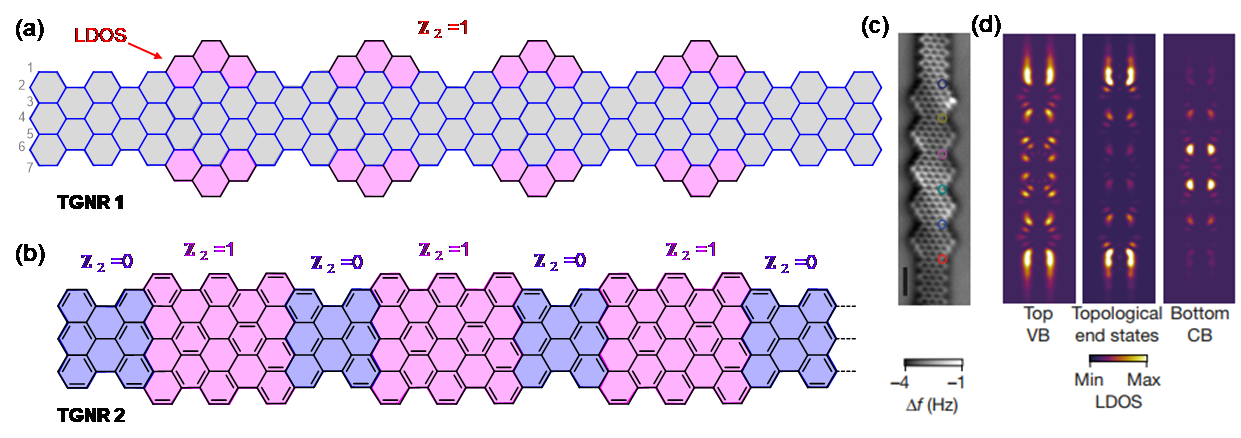Planar Carbon Lattices
RTG-2861-PCL
A2 - Bottom-up synthesis of topological graphene nanoribbons
Principal investigator: Prof. Dr. Xinliang Feng, TU Dresden, [webpage]
Doctoral researcher in the 1st cohort: Boris Borisov
Doctoral researcher in the 2nd cohort: Open position
Graphene nanoribbons (GNRs) – narrow stripes of graphene, are quasi-1D materials that are emerging as promising candidates for the next generation of carbon-based nanoelectronic devices.[1] Since the electronic properties of GNRs sensitively depend on their edge structure at the atomic level, the preparation of structurally well-defined GNRs with widths below 10 nm is of critical importance for both a fundamental understanding of the physics at the atomic scale and the subsequent implementation of high quality materials in electronic devices. At present, two main strategies towards the synthesis of GNRs have been developed, namely top-down and bottom-up approaches. Top-down methods, such as electron-beam lithography of monolayer graphene or longitudinal unzipping of carbon nanotubes, generally suffer from low yields and non-uniform widths, as well as ill-defined edge structures. In contrast, bottom-up methods by combining in-solution and on-surface syntheses allow one to construct a wide range of precision GNRs with tunable electronic properties by controlling the width, edge topology, and end termination.[2] Very recently, the topological properties of GNRs have received a significant attention due to the potential applications in spintronics and quantum computing.[3] However, the synthetic strategy to making topological GNRs (TGNRs) is still quite limited due to the unavailability of suitable laterally extended molecular precursors. Here we will focus on the design and bottom-up precision synthesis of TGNRs, as well as on the exploration of the characterization methods for the topological properties of the as-synthesized GNRs.

Figure: Schematic representation of TGNR 1(a) and 2 (b) synthesized on Au(111) surface. (c) Constant-height nc-AFM image of TGNR 1. (d) TB simulated charge-density maps at the top of the VB, at E = 0 eV, and at the bottom of the CB, computed for the experimental structure in (c). Partially adopted from [3].
The aim of the project is to develop the bottom-up synthetic strategies for TGNRs and to explore their functionalities and properties.
Thesis topic 1st cohort: Synthetic strategies and methods for topological GNRs with heteroatom doping and non-hexagonal rings
We will develop the precursor design and synthetic methods/strategies for TGNRs by introducing the heteroatoms (different atom type (B or N) and doping position, and concentration) on the interior or periphery of GNRs. We will also incorporate the non-hexagonal rings (pentagon, heptagon) in the ribbon backbone. Towards this end, synthetic strategies towards the formation of non-hexagonal rings prior or during the key step of intramolecular cyclodehydrogenation needs to be established. Both approaches will allow for precisely tailoring the band structures and topological states of GNRs. We will collaborate with Heine on the theoretical study of the TGNRs and Maultzsch on the spectroscopic characterizations of as-synthesized GNRs.
Thesis topic 2nd cohort: Synthetic development of topological and chiral GNRs
[2] W. Niu, J. Ma, X. Feng, “Precise Structural Regulation and Band-Gap Engineering of Curved Graphene Nanoribbons”, Acc. Chem. Res. 2022, 55, 23, 3322–3333.
[3] O. Gröning, S. Wang, X. Yao, C. A. Pignedoli, G. B. Barin, C. Daniels, A. Cupo, V. Meunier, X. Feng, A. Narita, K. Müllen, P. Ruffieux, R. Fasel, “Engineering of robust topological quantum phases in graphene nanoribbons”, Nature 2018, 560, 209-213.
